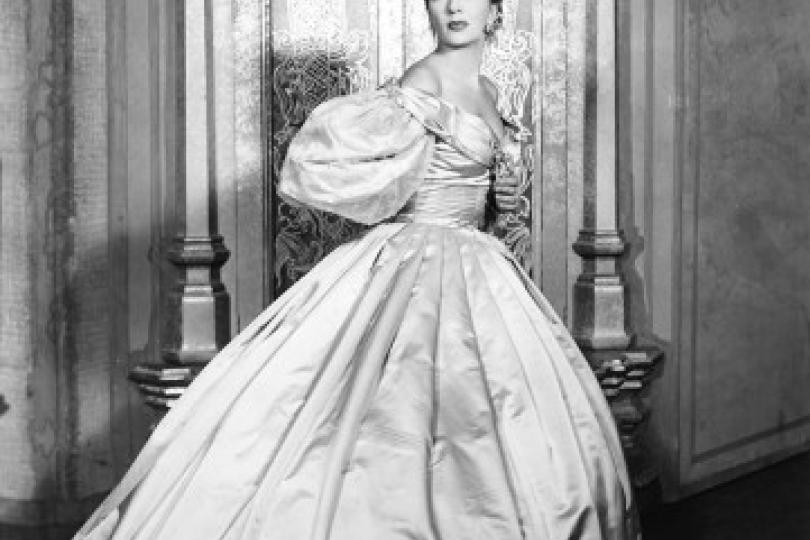Beatrice Lillie, Gertrude Lawrence and Peggy Wood

Many of those discussed in this series are remarkable individuals, and when assembled here, it’s easy to see how their careers were something every performer can envy.
Lady Peel from Canada
Of all the stories about the remarkable Beatrice Lillie (1894-1989), the most famous one occurred when Lillie was in Chicago and having a dress fitted. Either Mrs. Oscar Mayer or Mrs. Swift (the names vary) was upset because the actress was taking her time. When Lillie finally emerged, she directed the staff to “tell the butcher’s wife that Lady Peel has finished.”
And she was, indeed, Lady Peel, the wife of Sir Robert Peel, 5th Baronet. The Peels weren’t especially wealthy aristocrats, in part because their estate was extremely costly. Still, they married in 1920 and ended only because her husband died after being thrown from a horse in 1934. Their son, British Naval Officer, Sir Robert Peel, 6th Baronet, was killed in action in Ceylon (now Sri Lanka) in 1942.
Early Life and Career
Beatrice Gladys Lillie was born and raised in Toronto, and was, in her enchanting autobiography, Every Other Inch a Lady, a born performer. Along with her mother and sister, she appeared in vaudeville, performing in London’s West End as World War I began. Her parodies and sense of absurdity made her increasingly popular, and she’s renowned for her rendition of “There are Fairies at the Bottom of My Garden.”
Along with Noel Coward, Jack Buchanan and Gertrude Lawrence, she made her American debut in Andre Charlot’s Revue of 1924. The revue format suited Lillie and lasted until the late 1930s. Her most noted routine was "One Dozen Double Damask Dinner Napkins." In it, a bewildered matron tries purchasing these napkins without the help of her personal maid. She included among her costars, Bert Lahr and Jack Haley from Wizard of Oz.
Lillie loved to tour! In Kansas City, where her billing read “Lady Peel, direct from London and the Palace,” when Lillie took her bow, the audience stood and bowed back to her, because they thought that’s what you did with royalty. Following a tour on the Orpheum circuit (Minneapolis included), she starred in the West End in Coward’s The Year of Grace, where she introduced his “Mad Dogs and Englishmen.” She also starred in the London production of Jerome Kern’s Oh, Boy!, although for some reason it was retitled Oh, Joy! in the West End. Cole Porter wrote material for her, and she was among the most requested performers to entertain the troops during World War II. Her Tony-winning solo play, An Evening with Beatrice Lillie and the Ziegfeld Follies of 1957 were two more opportunities to see the gifted comedienne performing her popular songs and sketches.
“I’m Your Auntie Mame!”
In 1958, Rosalind Russell went to Hollywood to make the movie, her replacement Greer Garson had a movie commitment, so Beatrice Lillie took over the role of Auntie Mame, closing the show on Broadway and starring in London for a year. Upon seeing Lillie’s performance, which she enjoyed, Russell asked the producers “what the hell was I doing in it for 18 months?”
Madame Arcati sings!
In 1964, Blithe Spirit was made into the musical, High Spirits. Edward Woodward (The Equalizer) was cast as Charles and Tammy Grimes was the perfect choice for the ghostly Elvira. Lillie starred as Madame Arcati, and gave the role her all, opening the show with the energetic “Bicycle Song.” The highlight, however was her dance in bunny slippers as she sang a love song to her Ouija Board. Lillie was nominated for a Tony, but the honor went to Carol Channing for Hello, Dolly! High Spirits was her last stage performance. Lillie wrote a travelogue about Mr. Lee, her celebrated Pekinese titled Take a Poke. The book received a lot of press, but was never published.
The Movies
Lillie had appeared in silent films, but was lauded for her performance in On Approval (1944), based on the play by Fredric Lonsdale. Like many others, she had a cameo as a Salvation Army General in Around the World in 80 Days. Perhaps her most familiar role to modern audiences is as Mrs. Meers in Thoroughly Modern Millie. Sadly, Lillie’s performance is uneven, because, during filming, she couldn’t remember her lines. Julie Andrews often stood off camera and fed them to her. She retired following this film and was diagnosed with Alzheimer’s Disease. Beatrice Lillie has a star on the Hollywood Walk of Fame, she was painted by Neysa McMein and admirers of the artist Modigliani often see Lillie in his portraits of women with elongated faces. She died in 1989.
A Legendary Star from the UK
In the 1954 A Star is Born, James Mason tells Judy Garland about Ellen Terry and about performers with that “little something extra,” that spark you get when a natural performer takes the stage. They are a force to be reckoned with, and Gertrude Lawrence (1898-1952) was certainly that. Like her great friend, Noel Coward, Gertrude Lawrence was a child performer, touring the provinces until their London debuts. Along with close friend Beatrice Lillie, she starred in London Calling! for which Coward wrote songs and sketches. In 1924, she became the toast of Broadway.
Gertrude Alexandra Dagmar Lawrence Klasen was born in Newington, near Elephant and Castle, now the end of the Bakerloo and Northern lines on the London Tube. Her father, Arthur was Danish, but changed his name when he arrived in London. An alcoholic, his mother took the baby Gertie and moved as soon as possible. At 17, she married Francis Gordon-Howley, 20 years older than she, and gave birth to her only child, Pamela. Because her career came first, Gertrude Lawrence was a terrible mother.
The Actress and her Roles
Oh, Kay, Private Lives, Tonight at 8:30, Skylark, Lady in the Dark, Nymph Errant, Pygmalion, Susan and God, September Tide, The King and I – these are some of the productions she starred in. Only two notable films are part of her resume: Rembrandt starring Charles Laughton, and the first film version of The Glass Menagerie. She was the first choice to play Margo Channing in All About Eve, but negotiations fell through. She was Kaufman and Hart’s model for Lorraine Sheldon in The Man Who Came to Dinner. Late in her career, Gertrude Lawrence also taught Master Classes in Acting at Columbia University as well.
Gertie’s Loves
While she had that “little something extra” as a performer, she also had an insatiable appetite for sex. While there’s a thin line between reality and life as Lawrence chose to reveal, among her dalliances were producer Gerald Du Maurier, and presumably, later, his daughter, Daphne, the author of such thrillers as Rebecca and My Cousin Rachel. Captain Philip Astley, Douglas Fairbanks, Jr. and Edward VIII, who abdicated with his true love, Wallis Simpson and was renamed the Duke of Windsor, as well as Yul Brynner enjoyed spending time with the star. According to Noel Coward, this was somewhat surprising, because, when the cameras were present, she radiated a luminescent beauty, but without make-up, people rarely recognized her.
Whatever baubles and charms men may have bestowed upon her, in 1935, Lawrence faced the reality of bankruptcy. She worked herself to exhaustion, but paid off her debts. In 1941, she married wealthy lawyer-producer Richard Aldrich. This made her financially secure for the rest of her life. When America entered World War II, Aldrich enlisted in the Navy and Lawrence kept herself busy, alternating between entertaining the troops and bringing Lady in the Dark back to Broadway for 507 performances in three Broadway engagements.
The King and I
Gertrude Lawrence and her agent brought Margaret Landon’s book, Anna and the King of Siam to Rodgers and Hammerstein’s attention. As rehearsals progressed there were complaints about Lawrence’s temperament. There was a good reason for it.18 months into the run, she collapsed and was hospitalized. It was discovered that Gertrude Lawrence was suffering from liver cancer. Lawrence orchestrated her own funeral and aftermath. She asked that Yul Brynner be given star billing and that she be buried in the gown by Irene Sharaff designed for the “Shall We Dance” sequence.
Lawrence herself wrote the autobiography, A Star Danced, and Aldrich told his side of things in Gertrude Lawrence as Mrs. A. A two-hander revue with two titles: Noel and Gertie or If Love Were All is available for production, and Julie Andrews played Lawrence in the film Star!
Savaged by the critics when it was released, the film was restored and released on DVD. Episodic, with much of her life eliminated (including her friendship with Beatrice Lillie) or paired with unrelated information, it follows her life from Music Hall performer to starring in Lady in the Dark. Several theatrical moments are recreated, including the balcony scene from Private Lives, scenes from Tonight at 8:30 and a dazzling rendition of “The Saga of Jenny.” Star! plays better on television than it did in theaters, too.
The American Stage, Screen and Television Star
Of the trio in this article, Mary Margaret “Peggy” Wood (1892-1978) is the least well known, but had a career any working actor would envy. Her most famous performance was as the Mother Abbess in The Sound of Music, for which she was nominated an Oscar and a Golden Globe as Best Supporting Actress. Her father was a journalist, as well as a direct descendent of Daniel Boone.
Operetta Star and Algonquin Wit
Peggy Wood had a beautiful, lyric soprano voice, which led to a career of five decades. She performed in the ensemble of Naughty Marietta, but by 1917, was both a proud member of Actor’s Equity and the star of Maytime. A member of the Algonquin Round table, her most noticeable quip following lunch was, “Well, it’s back to the mimes.”
In the 1930s, she appeared in such films as A Star is Born, The Bride Wore Boots and Dream Girl. She also created the role of Ruth in the Broadway production of Blithe Spirit.
Mama
John van Druten’s dramatization of I Remember Mama was a successful play and film. For eight years, Wood played the role of Marta Hansen, Mama on television. Extremely popular, Mama was one of the first television programs to go into syndication, where it was also successful. Sadly, many of the kinescopes have been lost, although some are still available at the Paley Center for Media.
Wood returned to Broadway with Imogene Coca for Howard Teichmann’s wacky comedy The Girls in 509. Although dated now, it involves two women hiding in a desolate hotel since FDR’s election. They’ve pledged to hide until a Republican is elected. The play became a staple for community theater in the 1960s.
Movies, TV and Books
In 1960, she appeared onscreen in The Story of Ruth. This was followed by the role of the Mother Abbess. Because her singing voice was no longer in shape, Woods’ rendition of “Climb Ev’ry Mountain” was dubbed by Margery McKay, to Woods’ approval. She appeared on One Life to Live in 1969, and Wood wrote two autobiographies, a biography of John Drew, Jr. who was a member of the Barrymore clan, as well as a novel and a play.
She was awarded frequently for her work in later years and was President of the American National Theater and Academy. Peggy Wood passed on at the age of 86.
These women are truly remarkable individually, and together had careers any performer could envy!




